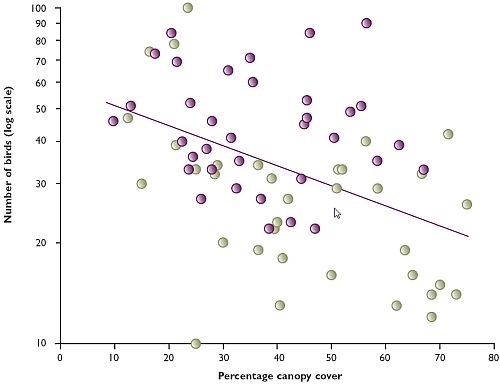Key findings
- Bird numbers in November-December were 1.5 times higher in woods where pheasants were released than in a comparable sample of non-game woods.
- On average, 13 species were recorded in game woods compared with 10 species in non-game woods.
- Bird communities of game woods contained higher proportions of woodpigeons and finches than those of non-game woods.
- Habitat management and supplementary feeding in game woods appear to explain these differences.
We know much less about what woodland birds need in winter than we do about their needs in the breeding season. In winter songbirds have to move around more to find food and they use more energy in cold weather. Managing woods for game alters habitat and food supply and we were interested to learn how this affected songbirds in winter.
We counted birds seen and heard along a one-kilometre transect at each of 70 semi-natural oak and ash woods on the Hampshire and South Wessex Downs in November and December. Of these, 35 woods had pheasant release pens and a supply of extra winter food. The remaining 35 woods had no recent (within the last 25 years) history of game management. We measured vegetation cover in the field, shrub, understorey and canopy layers as well as tree diameter at breast height, which is related to tree age.
Our analysis took account of weather and neighbouring woodland. Overall, we found that there were 1.5 times as many birds in game woods compared with non-game woods (see Figure 1). The number of species was also higher, averaging 13.0 in game woods compared with 10.4 in non-game woods.
The three most numerous species in both game and non-game woods were woodpigeon, long-tailed tit and blackbird. However, the bird communities differed between game and non-game woods, with higher proportions of woodpigeons and finches in game woods. Nevertheless, bird numbers were still 1.4 times higher in game woods even when woodpigeons and rooks, another flocking species, were excluded.
Figure 1: Mean bird numbers per kilometre in 35 game and 35 non-game woods on the Hampshire and South Wessex Downs in November-December

How can we explain these differences? Separating the effects of habitat management and supplementary feeding will require more work, but we think that both play a role in attracting more birds. We found that bird numbers increased as tree canopy decreased (see Figure 2).
On average, the canopy was more open in game woods than non-game woods (37% compared with 45%) and tree diameter was larger (42cm compared with 37cm). This indicates that more thinning or skylighting has been done in game woods and partly explains the higher bird numbers. However, although pheasant release pens are generally sited strategically, game managers may select better, older woods for release pens, which may have had more songbirds in the first place.
Figure 2: Relationship between total number of birds and canopy cover

Note the tendency for game woods to have less canopy cover and higher bird numbers.
To look at the effect of food (typically wheat) put out for pheasants, we split the game woods into those where food was supplied using a spinner on a quad bike (17 woods) and those where food was supplied via hoppers, either solely or in conjunction with spinner feeding (18 woods). We had seen various songbirds feeding at hoppers and supposed that if supplementary food influenced their numbers, the effect might be more pronounced in woods where the food was concentrated and easily obtained (i.e. at hoppers) than in woods where it was less abundant and harder to find. This was indeed the case for chaffinch, the species most commonly seen at hoppers, whose numbers were 2.5 times higher in woods with hoppers. We also found that woodpigeon numbers were 3.5 times higher in these woods.
In future, we aim to clarify and support these findings, but our first impression is that pheasant management does increase the attractiveness of oak-ash woods for many birds in winter.
Sustainable Gamebird Releasing - Free Guide
Simply enter your email address below to download your essential free guide.
 What's inside your FREE guide
What's inside your FREE guide
✓ Background to releasing
✓ Woodland release pens
✓ Hedgerows & Game crops
✓ The precautionary approach
✓ Case study - pheasant releasing
*You may change your mind any time. For more information, see our Privacy Policy.